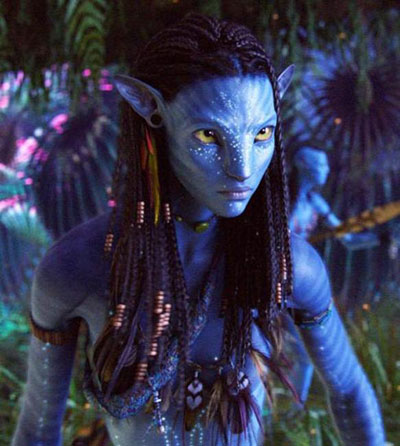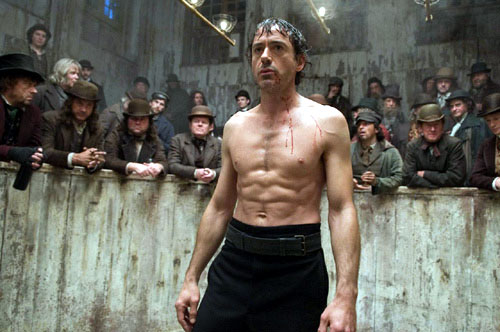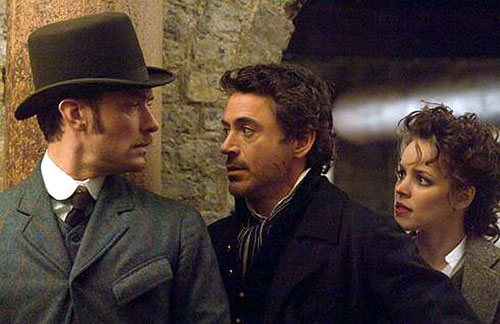|
I have seen the future, and it works. Kinda. Sorta. Maybe. I hope.
That future is the future of the cinema, as represented by the most financially successful, most technologically advanced film in history: James Cameron's Avatar.
From the standpoint of CGI, 3D, IMAX and any other acronym you can think of, Avatar is a wonder. From the giant, magnificently colored flowers and forests of the planet Pandora; to its terrifying, awe-inspiring bestiary; to the Magritte-like majesty of its floating mountains, with waterfalls descending to mind-boggling depths: Cameron and his technical crew have created a cross between the dreamiest children's-book illustrations you've ever seen and the rip-snortingest theme park rides you've ever ridden.
With Avatar, Cameron reaffirms his gifts as a technical innovator and visual storyteller—which is fortunate, because here he also reaffirms his total lack of imagination regarding characters and dialogue. Everything we see in the story of Avatar, we've seen before, and better. Edgar Rice Burroughs—especially his John Carter of Mars series of books—and Dances with Wolves are most often cited by reviewers of Avatar, though Star Trek, Star Wars and Disney's Pocahontas are in there too. But without the constant jaw-dropping visuals, Avatar would put us to sleep pretty quickly.
Much has been made of the "performance capture" techniques—pioneered by Peter Jackson in his Lord of the Rings trilogy—that Cameron used to create the Na'vi people of Avatar. In performance capture, actors stand on a motion-capture stage, wearing skin-tight body suits covered with reflective markers. Cameras record data that are fed into a computer, creating 3D images the director can add to as he or she pleases.
 |
The Na'vi—ten feet tall, with blue skin, mandrill-like markings on their faces, and feline tails and eyes—are certainly compelling visually. Arguments continue as to where the computer ends and the actor begins in performance capture, and as to what precisely it portends for screen acting as we know it. I am dubious, to say the least, about directors being able to alter or even obliterate the work of actors technologically. On the other hand, the technique worked spectacularly in The Lord of the Rings; the Gollum created by Jackson and Andy Serkis was a fantasy creature of heretofore unimaginable realism. The Na'vi don't impress me as much as Gollum did, but the excellent actors playing Na'vi characters—Wes Studi, CCH Pounder, and especially Zoe Saldana as the warrior princess Neytiri—manage to project a spark of life and personality through all the CGI.
But again, it's too bad the actors and the special effects surrounding them are so resoundingly better than the lines they're given to say. The Na'vi are less characters than a mass visual marvel, and the actors portraying Homo sapiens don't even have the visuals going for them. The characters of Jake Sully (Sam Worthington), Grace Augustine (Sigourney Weaver), Miles Quaritch (Stephen Lang), and Parker Selfridge (Giovanni Ribisi) come straight out of computer files marked Callow Young Hero, Cynical Scientist, Irredeemable Villain and Self-Centered Yuppie Twerp. Cameron already plundered these files, and others like them, in Aliens, The Terminator and Titanic. (Michelle Rodriguez has more juice than the other non-Na'vi actors as the chopper pilot Trudy, but she too is hobbled by cliché.)
The quirks Cameron gives the characters do nothing to bring them to life, or help the actors bring them to life. Jake Sully's paraplegia, for instance, doesn't make the character more interesting; it only gives him one more reason to want to trade in his human body for a brand-new Na'vi one. Of course, Cameron doesn't want you to care about Jake's character motivations. He wants you to hold on to your seat as Jake, in his avatar body, rides an Ikran—a bloodcurdling flying dragon—for the first time, swooping ten thousand feet above a churning abyss. And, indeed, you do just that.
Avatar reminds us once again that Hollywood pitches most of its movies to twelve-year-old boys, who are the most reliable buyers of movie tickets. But at least Cameron deserves credit for trying to create an original story, albeit a clichéd one. When Young Turk directors turn their attention to a traditional story, little good generally comes of it, and little good comes of Guy Ritchie's Sherlock Holmes, taken (as far as possible) from Arthur Conan Doyle by screenwriters Michael Robert Johnson and Anthony Peckham. Ritchie, Johnson and Peckham take the Sherlock Holmes saga, one of the great adult entertainments of all time (by which I mean Conan Doyle wrote for people with mature minds) and turn it into a sub-literate boy's story. It's not Conan Doyle so much as Conan the Barbarian.
 |
If you knew little of Sherlock Holmes coming to Ritchie's movie—and obviously Ritchie is counting on that—his Sherlock Holmes would strike you as a serviceable buddy-adventure flick. The grungy Victorian London sets are convincing, the special effects are state-of-the-art (or at least they were until Cameron released Avatar), and the basic plotline of a murderous nobleman (Mark Strong) who leads a weirdo cult is more or less in the Holmes tradition. Everything else in the movie, however, owes far less to any previous Sherlock Holmes story than to Lock, Stock and Two Smoking Barrels. Conan Doyle's Holmes had his crotchets (brought out memorably by Jeremy Brett in the Granada TV series of the 1980s), but above all he was a rational, highly educated Victorian gentleman. There is no sense—absolutely none--in making the character as feral, crude and unsocialized as Ritchie, Johnson and Peckham do. The best you can say is that Robert Downey Jr. makes the character more likable as played than as written, and that he looks good in the shaggy shoulder-length haircut Ritchie gives him.
Jude Law, however, has looked better than in the prissy mustache and bowler, and the even prissier expression, Ritchie makes him wear as Dr. Watson. The popular image of Watson—as the vague, bumbling clown playing by Nigel Bruce opposite Basil Rathbone's Holmes—is admittedly anti-Conan Doyle, but so is the grim tightass with a gambling problem played by Law.
 |
Downey's Holmes and Law's Watson are less amiable versions of the bickering cops played by Mel Gibson and Danny Glover in the Lethal Weapon movies. Similarly, Irene Adler (Rachel McAdams), instead of the enigmatically fascinating figure in Conan Doyle, here is just another riot grrrl with a penchant for chaining her boyfriends naked to hotel beds. All of Ritchie's inventions are annoying, up to and including his patented gear-screeching sound effects as he backs up the story to revel in what just happened. Why does Ritchie make Holmes an avid participant in bare-knuckle boxing matches? Because Ritchie loves the sight of blood gushing from under a fist, and he thinks you do, too. No matter that it doesn't advance the story one atom.
I hear Ritchie is gearing up for a Holmes sequel; if so, he'd better be thinking about making it 3D. According to an article by Gary Susman on Moviefone.com, the Disney organization—to name only one studio—is green-lighting only 3D special-effect spectaculars or low-budget teen flicks featuring young actors it already has under contract. "Mid-range movies driven by actors are out," Susman writes. There were plenty of good mid-range, actor-driven movies around this past year—A Single Man, Crazy Heart, Up in the Air, The Hurt Locker by Cameron's own ex-wife—but it looks as if, thanks to Avatar, there will be many fewer, at least in the foreseeable future.
I think of District 9, a movie from this past year that combined spectacular (though not 3D) special effects with a truly involving sci-fi story and excellent performances. I think of special effects masters of the past, such as Michael Powell. The effects in The Thief of Bagdad, Black Narcissus and The Red Shoes look crude next to those in Avatar. But they are more beautiful from an esthetic standpoint, and done more in the service of memorable stories and characters. It's hard to imagine Powell feeling the need to envelop Deborah Kerr and Moira Shearer in computer-generated faces and bodies, even if he had been able to do it.
Will there be room in the future for movies that let actors be actors and speak dialogue that is more meaningful than the special effects? Will "performance capture" be used to enhance, not erase, the contributions of actors? Or are we marching inexorably toward an era in which actors are puppets, the screenwriter a supernumerary, and the tech wizard of the hour the King of the World? If it is the latter, don't worry—the cinema will survive. Kinda. Sorta. Maybe. I hope.
|

